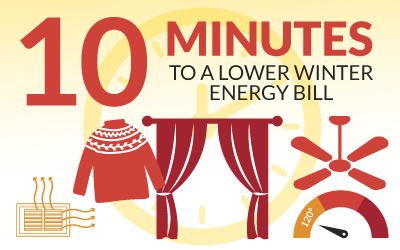January is typically the coldest month of the year here in Georgia, pushing the typical homeowner’s energy bill higher. But a few household changes — many accomplished in just minutes — can make a big difference in how much you’ll pay.
Quick fixes
Turn on the timer and see if you can accomplish these five projects in 10 minutes or less. Ready…set…go!
- Unblock vents. Clear away furniture and drapes that may be blocking air coming out of vents, making your furnace work harder than it should. Blocked vents increase air pressure in your ductwork, which can create cracks and leaks. Clearing your vents ensures that every room in your home is getting good circulation and that your system is working as designed.
- Use the fan. Ceiling fans aren’t just for summer cooling; they can also be used to keep warm air circulating below the fan. To do this, reverse the motor in the ceiling fan so it rotates clockwise at a low speed. This will create an updraft which forces warm air near the ceiling down into the occupied space.
- Turn it down. Many conventional water heaters are set to 140 degrees Fahrenheit by installers, but most households don’t need that much steam, and end up paying for it. Lowering the temperature to 120 degrees Fahrenheit (or lower) can reduce your water heating costs by 6% to 10%.
- Open the drapes. Let the sun shine in during the day to help heat a room. Remember to close drapes and shades across all of your windows at night to prevent drafts and slow heat loss through the glass.
- Bundle up. Put on a sweater instead of cranking up the heat. Experts recommend lowering your thermostat a few degrees during the day and then lowering it even more at night. You can save as much as 10% off your heating bill by turning your thermostat down 7°to 10°F for just 8 hours a day.
More energy-saving ideas
Have a few more minutes to spare for the sake of controlling your energy bill? Here are five more easy ways to save.
- Dodge the drafts. According to the U.S. Department of Energy, drafts can waste 5% to 30% of your energy use. Use this easy trick to check for drafts: Close the window or door on a one-dollar bill. If you can pull the bill out of the closed door or window, it’s time for new weatherstripping or caulk. Plus, door sweeps help seal the space between the bottom of your door and the door frame. And even draft stoppers can give you some measure of protection from the cold.
- Focus on filters. Yes it’s easy to forget, but it’s important to replace or clean heating system filters once a month during colder months. Dirty filters restrict airflow and increase energy demand. Tip: Mark a date on your calendar to change filters. If your filters are disposable, stock up on enough new ones to get through the winter.
- Suck it up. A clean furnace runs much more efficiently, so vacuum any debris or accumulated dust around the furnace filter. Then, tackle the vents throughout the house.
- Wrap up. Invest in an inexpensive insulated blanket to wrap your water heater. This is especially helpful if the water heater is in an unheated area, such as a garage. If it is well-insulated, it has less work to do to heat your water, which means more energy-efficiency.
- Switch to a smart thermostat. A smart thermostat is a high-tech way to save electricity in the winter. Programmable thermostat savings come from the ability to fine-tune and optimize when your furnace runs. You can program the thermostat to turn down while you’re sleeping or when you’re away and then set it warmer for just before your arrival back home at the end of the day.
Accomplishing even a few of these energy-saving projects will help keep you comfortable all winter long without breaking the bank.

